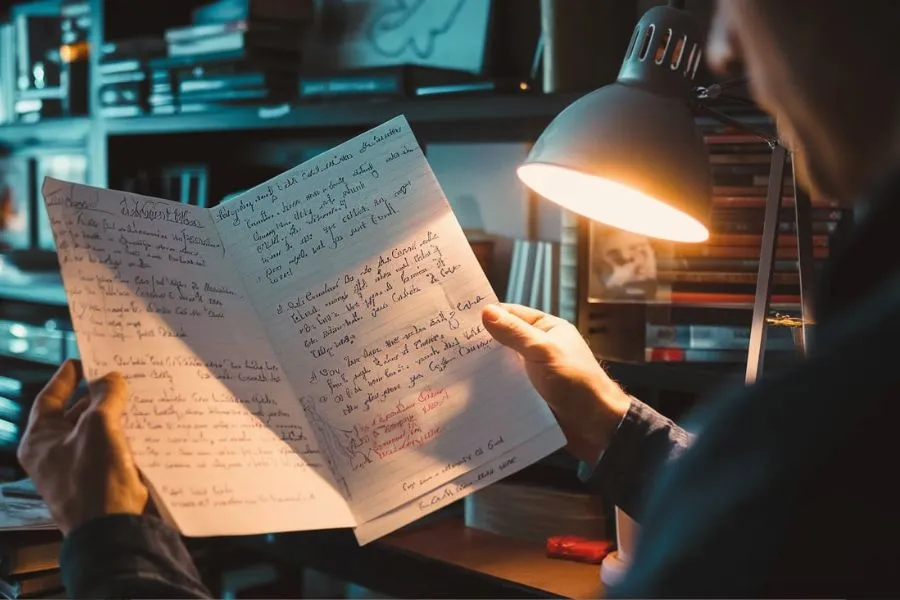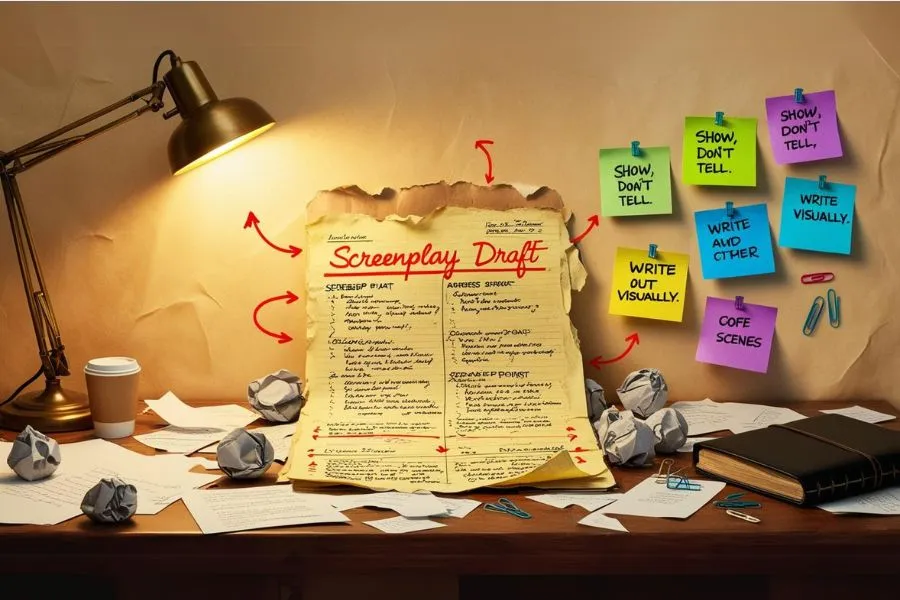Table of Contents
The handwritten screenplay draft stands as a unique and deeply personal method for storytellers to connect with their work. If you’re someone who loves the tangible feel of pen on paper or finds creativity flows more freely through the physical act of writing, then you’re in the right place. In this blog, we’re diving into the magic of handwriting your screenplay and exploring 7 techniques that will elevate your handwritten screenplay draft to a masterpiece.
What is a Handwritten Screenplay Draft?
Before we get into the techniques, let’s clarify what we mean by a handwritten screenplay draft. Essentially, it’s the traditional method of physically writing out your screenplay by hand, using notebooks, pens, and markers. This process can feel like an intimate conversation between you and your story. While typing is faster, handwriting can slow you down in a good way, allowing for a more thoughtful and deliberate process.
The Emotional Connection of Handwriting
One of the key benefits of handwriting your screenplay is the emotional bond it fosters between you and your story. There’s something undeniably personal about watching your story take shape through your own hand movements. Each stroke of the pen feels like you’re breathing life into your characters, your scenes, and your plot twists. Handwriting can also unlock deeper creativity.
When you’re typing, your brain sometimes gets stuck in the mechanical rhythm of tapping away at the keyboard. But with handwriting, every pause to think, every doodle on the corner of the page, and every crossed-out line serves as part of your creative process.
Choosing the Right Tools for Your Handwritten Screenplay
Not all pens and notebooks are created equal! When handwriting a screenplay, you want tools that feel comfortable and smooth. Invest in a quality pen, something that won’t cramp your hand during long writing sessions. Some screenwriters love using fountain pens for their smooth ink flow, while others stick to classic ballpoints or gel pens.
Notebooks matter too. You’ll want something that lies flat and gives you enough room to brainstorm, scribble, and write out full scenes without feeling cramped. Leather-bound journals or spiral-bound notebooks are popular choices.
Handwritten Screenplay Draft Techniques

When handwriting a screenplay, balance is key. You want to maintain the structured format of a screenplay while also letting your ideas flow. Use visual techniques like arrows, doodles, and different colored inks to separate dialogue from action lines. These small details help organize your thoughts while giving your screenplay a visual flair.
1. The Role of Handwritten Notes in Character Development
- Sketching and doodling: Visualize your characters’ physical appearance and personality traits. A quick doodle might reveal a defining characteristic or quirk that you hadn’t considered before.
- Side notes: Write down their thoughts, motivations, and backstories. These notes can help you understand your characters on a deeper level and inform their actions and dialogue.
- Evolutionary process: Allow characters to develop naturally on the page. As you write, your characters may take on unexpected qualities or directions. Embrace this organic process and let them evolve as they need to.
2. Using Visual Cues in Your Handwritten Draft
- Highlighting and underlining: Emphasize important points or themes. This can help you identify key elements of your story and ensure they are woven throughout your script.
- Arrows and connections: Indicate relationships between scenes or characters. Visual cues can help you see how different elements of your story connect and flow together.
- Visual organization: Keep your thoughts organized and easy to follow. Use visual techniques like arrows, doodles, and different colored inks to separate dialogue from action lines and make your script more visually appealing.
3. Developing Themes Through Handwritten Screenplay Drafts
- Organic emergence: Themes often arise naturally when writing by hand. The slower pace of handwriting allows you to pay closer attention to your subconscious and let themes emerge organically.
- Breathing space: Allow themes to develop gradually throughout your script. Don’t feel pressured to force themes into your story. Let them develop naturally over time.
- Depth and richness: Create more nuanced and compelling themes. By allowing themes to emerge organically, you can create themes that are more deeply rooted in your story and resonate with your audience on a deeper level.
4. Handwritten Screenplay Formatting Tips
- Blank sheets or templates: Use pre-formatted templates for consistent formatting. This will help you maintain a professional appearance and make your script easier to read.
- Clear labeling: Label scene headings, action lines, and dialogue. This will help you stay organized and avoid confusion.
- Readability: Ensure your script is easy to read and understand. Use legible handwriting and leave plenty of space between lines.
5. Revision Strategies for Handwritten Screenplays
- Scanning or typing: Transfer your handwritten pages to a digital format for easier editing. This will allow you to make changes more easily and efficiently.
- Fresh perspective: The shift to digital can help you catch missed elements. Seeing your script in a different format can give you a fresh perspective and help you identify areas for improvement.
- Comprehensive revisions: Make more thorough edits and revisions. Once your script is in digital format, you can make more extensive changes and revisions.
6. Keeping Momentum with Handwritten Drafts
- Daily or weekly goals: Set achievable writing targets. Breaking down your script into smaller, manageable sections can help you stay motivated and make progress.
- Staying motivated: Find ways to stay inspired and focused. Listen to music, take breaks, or reward yourself for reaching your goals.
- Combining handwritten techniques with digital tools: If you love handwriting but want the convenience of digital tools, consider combining both worlds. Start with handwritten drafts and then transfer them to a digital platform for easier revisions and formatting.
7. Combining Handwritten Techniques with Digital Tools
- Hybrid approach: Start with handwritten drafts and then transfer them to a digital platform.
- Creative freedom and efficiency: Maintain the benefits of handwriting while utilizing digital tools.
Why Filmmakers Still Love Handwritten Drafts

There’s a reason some of the most famous filmmakers and screenwriters still prefer to write by hand. It’s not just nostalgia, it’s about connecting with the story on a deeper level. Handwritten drafts encourage filmmakers to slow down, think more carefully, and let the story unfold naturally.
Conclusion
Handwriting your screenplay draft may seem like an old-fashioned technique, but it offers unparalleled creative benefits. From deepening your connection with your characters to enhancing your storytelling through personal touches, the handwritten screenplay draft is a technique worth trying. Whether you’re a seasoned screenwriter or just starting out, give it a go, and see how your creativity blossoms!
FAQs
1. Can a handwritten screenplay draft be professional?
Yes! Many professional screenwriters prefer to start with a handwritten draft before transferring it to a digital format.
2. What if my handwriting is messy?
Don’t worry! The point is to get your ideas down. You can always clean things up when you transfer your screenplay to a digital format.
3. How long should a handwritten screenplay draft take?
It depends on the writer, but the slower pace of handwriting often leads to deeper thinking. Take your time!
4. Is it practical to use handwriting in modern screenwriting?
While digital tools are faster, handwriting adds a personal and creative layer to your storytelling process.
5. What tools do I need for a handwritten screenplay draft?
A good pen, a comfortable notebook, and a quiet space are all you need to get started!

